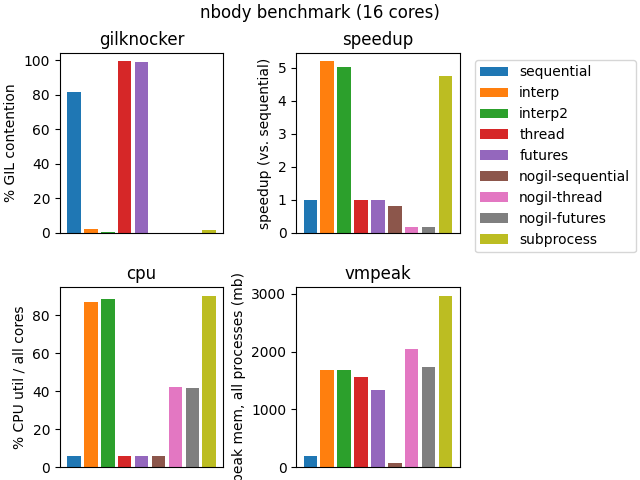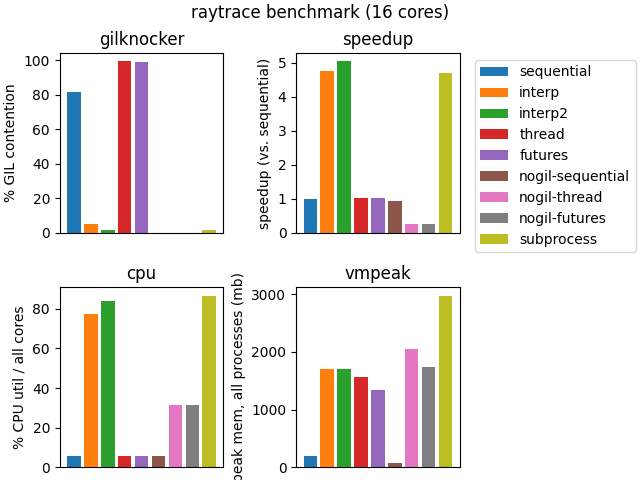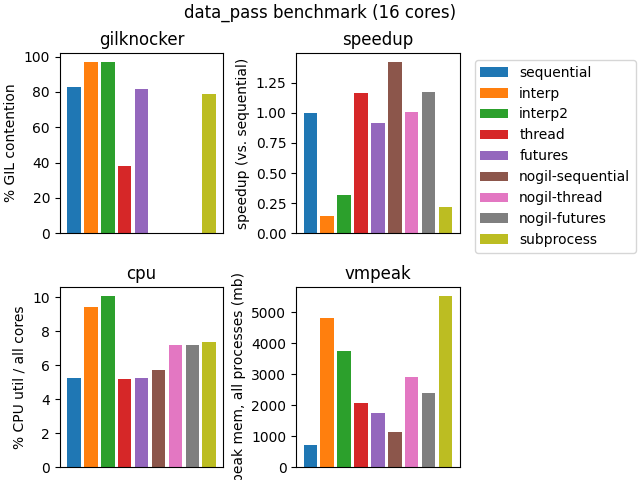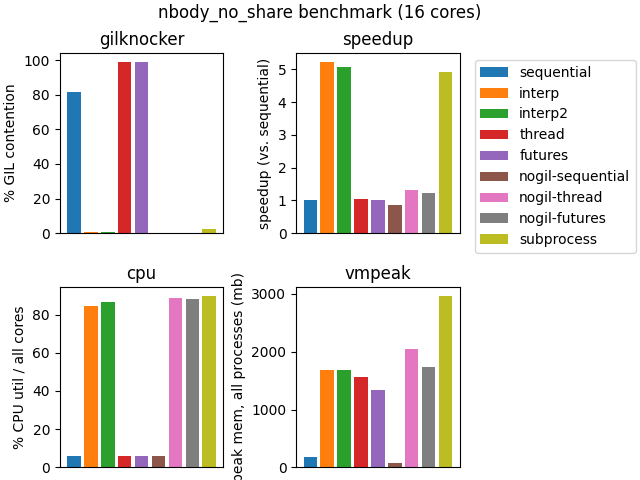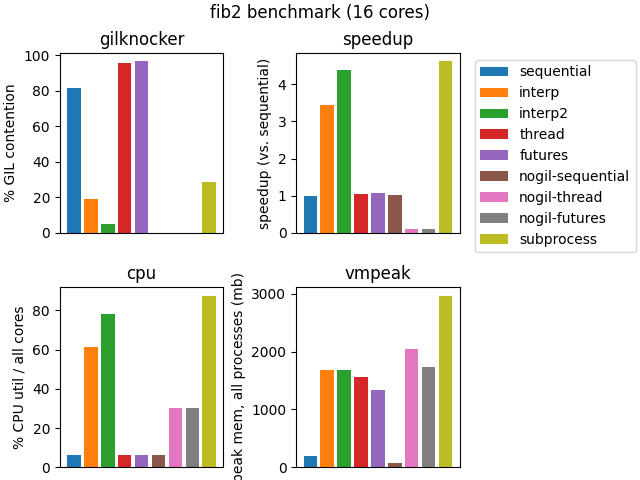Experiments with building a multiprocessing.pool.SubinterpreterPool out of the
per-interpreter GIL support in Python 3.12. Also comparing to alternative
approaches, including multiprocessing.ThreadPool, multiprocessing.Pool,
concurrent.futures.ThreadPoolExecutor, with and without nogil.
All of these benchmarks compute the same thing X number of times, either sequentially or in a pool of 16 workers on a 8 core / 16 virtual core machine.
Calculates fibonacci(28) 64 times. Taken directly from the nogil README.
The nbody benchmark from pyperformance, doing 10 iterations each time, 64 times.
The raytrace benchmark from pyperformance. Renders a 100x100 image, 64 times.
A do-nothing benchmark that passes 0.5 MB of data 64,000 times to measure the overhead of message passing.
Uses the gilknocker library, which reports the percentage of samples in which the GIL was held. A rough measure of "GIL contention".
This library doesn't work with the nogil branch, so we report 0 there. This
doesn't mean there isn't lock contention over shared data structures, however,
we just don't have a good way to measure that at the moment.
The speedup vs. the naive sequential approach.
Percentage utilization across all cores of the machine.
Peak memory usage. For subprocessing, includes the memory of all child processes.
Run the work purely sequentially, using map.
As experimental multiprocessing pool using subinterpreters.
As with regular multiprocessing using subprocesses, each worker in the pool
has its own thread in the main interpreter. Inside each of those threads, a
subinterpreter runs multiprocessing's existing "work handler loop", unmodified.
Since a queue.SimpleQueue can not be used to send objects between
subinterpreters, work is sent to this loop inside the subinterpreter using a
LockableBoard from the extrainterpreters
project. Objects can be added and
removed from a LockableBoard from multiple subinterpreters, and it enforces
that only one subinterpreter can access an object at a time. The object must be
a sharable type, so the objects are pickled/unpickled in order to send back and
forth, but the pickle data itself does not need to be copied.
Since the worker loop needs to block waiting for more tasks and the result
handler needs to block waiting for more results, an os.pipe is used to
ommunicate between interpreters when new data is ready to be read from the
LockableBoard.
Experimentally, this was much faster than polling in a Python loop, but I don't know whether this is the most efficient synchronization primitive for this purpose (it was definitely handy).
(extrainterpreters also contains a Queue class that is more like what is needed, but it doesn't appear to support blocking reads yet.)
As above, each worker in the pool starts a new thread in the main interpreter. Each of these threads has exactly one subinterpreter contained in it, but rather than that subinterpreter running the work handler loop, it remains running in the thread on the main interpreter, and each task is sent individually to its subinterpreter.
Since the work handler is just a regular thread, it can use queue.SimpleQueue
to receive tasks and return results.
When a task is received from the queue in the worker thread, the task data is
pickled and sent to the subinterpreter using interpreter.run().
A modification to interpreter.run() was made (going beyond PEP554) to run code
in eval mode, so that a return value can be obtained and returned. For safety,
this enforces that the return value is of a subinterpreter-shareable object. To
support all objects, the code that runs a task inside a subinterpreter returns a
pickled copy of the return value.
Specifically, the following code is run when initializing each subinterpreter:
import pickle
def _f(p):
func, args, kwargs = pickle.loads(p)
return pickle.dumps(func(*args, **kwargs))And the following code runs each task, where pickle is a (func, args, kwargs) triple:
_f({pickle!r})Uses multiprocessing.ThreadPool. Here, one would expect GIL contention to produce a time similar to the sequential mode.
Uses concurrent.futures.ThreadPoolExecutor. Should have similar performance to thread, but included for completeness, especially since this is the framework used for nogil benchmarking.
Does the work sequentially, using map, on the nogil branch of CPython.
Uses multiprocessing.ThreadPool on the nogil branch of CPython.
Uses concurrent.futures.ThreadPoolExecutor on the nogil branch of CPython.
Uses multiprocess.Pool using subprocesses.
The nogil mode runs on the colesbury/nogil-3.12/nogil-3.12-bugfix fork of CPython (hash ef5bac94).
That commit segfaults when running the nbody benchmark, so I disabled specialization to get it to run.
To account for this variable, I also disabled specialization on the upstream CPython used for the non-nogil benchmarks.
The nogil results are interesting. For the fib benchmark, which is the same benchmark in nogil's README, there is a clear speed advantage over all other approaches. nbody, however, hits a pathological case, as it mutates a dictionary shared across threads, and therefore underperforms sequential, as well as threading-with-GIL. (Also of note is that the results are incorrect because of this, but the goal here is not to prevent all bugs.) I made a modified version of the benchmark, nbody_no_share that deepcopys the data at the beginning of each task and uses that copy for computation. The results are much improved in this case, and nogil-thread out performs nogil-sequential, but is still far behind subprocesses and subinterpreters.
The raytrace benchmark hits a similar pathological case with nogil. It does have some effectively immutable constants in global state.
One possible answer as to the cause is in the fib2 benchmark. It is a modification of the nogil's fib benchmark to use an instance that updates the data member on each call.
The original fib benchmark:
def bench(n):
if n < 2:
return 1
return bench(n - 1) + bench(n - 2)The fib2 benchmark:
class Fibonacci:
def __init__(self, x):
self.x = x
def calculate(self, n):
# This line doesn't actually matter for the calculation, but this is what
# causes the nogil threaded performance to drop precipitously.
self.x += 1
if n < 2:
return 1
return self.calculate(n - 1) + self.calculate(n - 2)
def bench(n):
f = Fibonacci(1)
return f.calculate(n)You see in this fib2 results that nogil with threads gets really stuck by updating a member on an instance -- an instance that, importantly, is not shared between threads. It takes 10x longer than calculating it sequentially (80s vs. 8s), and uses 40x as much CPU time doing it.
Linux perf somewhat backs up this finding. It measures 10% of time in _PyObject_GetInstanceAttribute when multithreading, and 0% (below threshold of measurement) when running sequentially.
That 10% number doesn't reflect the overall time penalty, but it is a strong signal.
I do not know whether this is just an isolated bug in nogil or something that is more fundamental.
I did try running this on the older fork of nogil based on Python 3.9, and it does not seem to suffer from this pathological behavior, so perhaps that is a good sign this can be fixed easily.
For the data_pass benchmark, you can see the advantage over approaches that are forced to pickle/serialize (subintpreters and subprocesses) and those that don't.
This requires:
- A branch of CPython that adds a SubinterpreterPool and disables specialization
- A branch of extrainterpreters that bypasses a safety check
- A branch of CPython-nogil that disables specialization
- GNU time installed and on the path
To reproduce these results:
-
Checkout the
subinterpreter-pool-memoryboardbranch of CPython from my fork into a directory calledcpythonsitting alongside this one, and build it. -
Checkout the
disable-specializationbranch of CPython from my fork into a directory calledcpython-nogilsitting alongside this one, and build it. -
Use
run.sh $mode $benchmarkto install the dependencies in a venv and run one specific mode:interp: SubinterpreterPool using a memoryboard for communicationinterp2: SubinterpreterPool usingqueue.SimpleQueuefor communicationthread: Use the existingmultiprocessing.pool.ThreadPoolsubprocess: Use the default subprocess-basedmultiprocessing.Poolsequential: Don't use multiprocessing at all, just run the same work sequentially
From one of the given benchmarks:
nbodynbody_no_sharedata_passraytrace
-
Use
get_data.pyto collect results from all modes, including nogil. -
Use
plot.pyto plot the data from a given benchmark.

